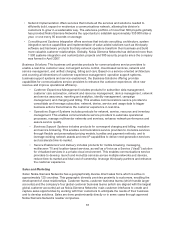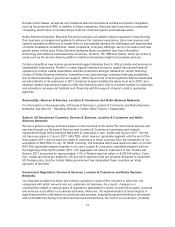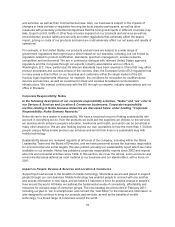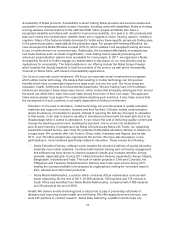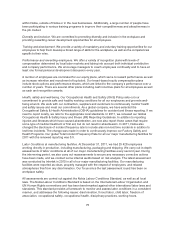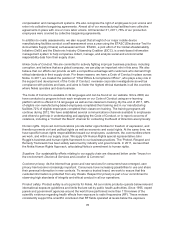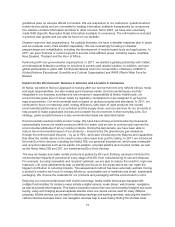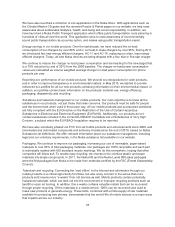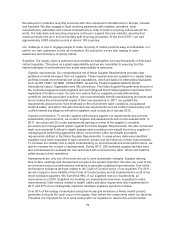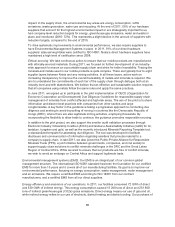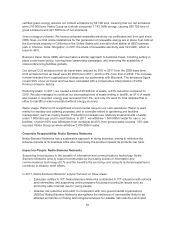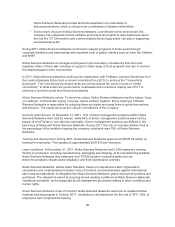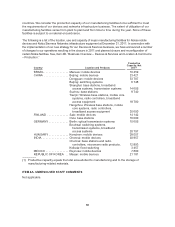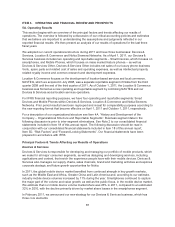Nokia 2011 Annual Report Download - page 79
Download and view the complete annual report
Please find page 79 of the 2011 Nokia annual report below. You can navigate through the pages in the report by either clicking on the pages listed below, or by using the keyword search tool below to find specific information within the annual report.guidelines pose no adverse effects to humans. We are responsive to our customers’ questions about
mobile device safety and are committed to making information available transparently for consumers.
Our website contains information and links to other sources. Since 2001, we have also voluntarily
made SAR (Specific Absorption Rate) information available to consumers. The information is included
in product user guides and can also be found on our website.
Disaster response and preparedness. As a global business, we have a disaster response plan in place
and we evaluate every crisis situation separately. We are increasingly focusing on disaster
preparedness and rehabilitation, including the development of mobile-based tools and applications. In
2011, we gave financial or in-kind support in several crisis-afflicted areas, including Japan, Australia,
New Zealand, Thailand and the Horn of Africa.
Partnering with non-governmental organizations. In 2011, we started a global partnership with Oxfam,
an International federation working on solutions to poverty and related injustice. In addition, we have
global partnerships in place with IUCN (International Union for Conservation of Nature), UNESCO
(United Nations Educational, Scientific and Cultural Organization) and WWF (World Wide Fund for
Nature).
Impact on the Environment: Devices & Services and Location & Commerce
At Nokia, we believe that our approach to looking after our environment not only reflects ethical, moral
and legal responsibilities, but also makes good business sense. Environmental issues are fully
integrated in our business activities and are everyone’s responsibility at Nokia. Additionally, our
environmental goals are not driven solely by regulatory compliance but are designed to go beyond
legal requirements. Our environmental work is based on global principles and standards. In 2011, we
continued to focus on materials used, energy efficiency, take-back of used products, the overall
environmental performance of our activities and the supply chain, and eco services for our products to
help people to make sustainable choices and consider the environment in their everyday lives. Our
strategy, goals and performance in key environmental areas are described below.
Environmentally-leading mobile product range. We have been driving environmental improvements
systematically across our mobile product portfolio for years, and we aim to continuously improve the
environmental attributes of all our mobile products. During the last decade, we have been able to
reduce the environmental impact of our products – measured by the greenhouse gas emissions
through the entire product lifecycle – by up to 50%, while also introducing new features and capabilities
that allow the mobile device to be used in many other ways than just for calling. In 2011, we introduced
five new Eco Hero devices, including the Nokia 700, our greenest smartphone, which uses renewable
and recycled materials such as bio-paints, bio-plastics, recycled plastics and recycled metals, as well
as the Nokia Asha 200 and 201, our lowest-priced Eco Hero devices.
The way we design and make mobile products is guided by life cycle thinking, aiming to minimize the
environmental impacts of a product at every stage of its life, from manufacturing to use and disposal.
For example, by using renewable and recycled materials, we are able to reduce the need for virgin raw
materials. Life cycle assessments help us identify and focus on the areas where we can make the
biggest contribution to reducing impacts. This assessment method has been externally audited. During
a product’s creation we focus on energy efficiency, sustainable use of materials and smart, sustainable
packaging. We choose the materials for our products and packaging with the environment in mind.
Reducing our environmental impact with mobile technology. Nokia mobile devices are equipped with
multiple functionalities; for instance many include a digital camera, music player, web browser, navigation,
as well as several other features. This helps consumers reduce their own environmental footprint and avoid
buying, using and charging several separate devices when one device can be used for many different
purposes. Mobile devices can be used for attending meetings and working remotely, reducing the need for
carbon-intensive business travel. Car navigation services help to save fuel by finding the shortest route.
77


